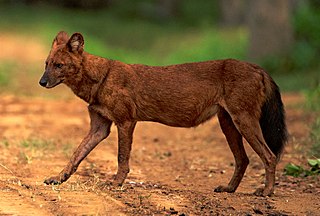
The dhole is a canid native to Central, South, East and Southeast Asia. It is genetically close to species within the genus Canis, but distinct in several anatomical aspects: its skull is convex rather than concave in profile, it lacks a third lower molar and the upper molars possess only a single cusp as opposed to between two and four. During the Pleistocene, the dhole ranged throughout Asia, Europe and North America but became restricted to its historical range 12,000–18,000 years ago.

Echinochloa is a very widespread genus of plants in the grass family and tribe Paniceae. Some of the species are known by the common names barnyard grass or cockspur grass.
Bipolaris glycines, or Drechslera blight, is a fungal plant pathogen of soybeans.

Setosphaeria rostrata is a heat tolerant fungus with an asexual reproductive form (anamorph) known as Exserohilum rostratum. This fungus is a common plant pathogen, causing leaf spots as well as crown rot and root rot in grasses. It is also found in soils and on textiles in subtropical and tropical regions. Exserohilum rostratum is one of the 35 Exserohilum species implicated uncommonly as opportunistic pathogens of humans where it is an etiologic agent of sinusitis, keratitis, skin lesions and an often fatal meningoencephalitis. Infections caused by this species are most often seen in regions with hot climates like Israel, India and the southern USA.

Setosphaeria turcica is the causal agent of northern corn leaf blight in maize. It is a serious fungal disease prevalent in cooler climates and tropical highlands wherever corn is grown. It is characterized by large cigar shaped necrotic lesions that develop on the leaves due to the polyketide metabolite monocerin.

Pleosporaceae is a family of sac fungi. They are pathogenic to humans or saprobic on woody and dead herbaceous stems or leaves.

Fungal meningitis refers to meningitis caused by a fungal infection.
Luttrellia is a genus of fungi in the family Halosphaeriaceae. The genus contains four species.
Setomelanomma is a genus of fungi in the family Phaeosphaeriaceae. This is a monotypic genus, containing the single species Setomelanomma holmiiM. Morelet (1980)
Keissleriella is a genus of fungi, that was originally placed in the Massarinaceae family, before being placed in the Lentitheciaceae family.

Monocerin is a dihydroisocoumarin and a polyketide metabolite that originates from various fungal species. It has been shown to display antifungal, plant pathogenic, and insecticidal characteristics. Monocerin has been isolated from Dreschlera monoceras, D. ravenelii, Exserohilum turcicum, and Fusarium larvarum.

Exserohilum curvisporum is a fungal species found during a survey done on water and sediment of the Shatt al-Arab at Basra, southern Iraq. The research was done by Basil A. Abbas under supervision of S. K. Abdullah in 1993.

Exserohilum is a genus of fungi in the family Pleosporaceae. The Exserohilum species are known for causing blight and human immune system diseases. The sexual reproductive states of Exserohilum species are known as Setosphaeria. The type species is Exserohilum turcicum. This genus is among three dematiaceous that are categorized for containing pathogens leading to diseases like phaeohyphomycosis.
Exserohilum antillanum is a species of fungus in the family Pleosporaceae. Found in Cuba growing on plant debris, it was described as new to science in 1995. The specific epithet antillanum refers to the Antillian sea, an old name for the Caribbean Sea. It is most similar in morphology to Exserohilum gedarefense, from which it differs in the size, pigmentation, and ornamentation of its conidia.
Exserohilum curvatum is a species of fungus in the family Pleosporaceae. Found in Venezuela, where it grows on the leaves of Sorghum, it was described as new to science in 1984. It differs from other Exserohilum species by its distinctly curved conidia.
Exserohilum echinochloae is a species of fungus in the family Pleosporaceae. Found in Bangladesh, where it grows on the leaves of Echinochloa colona, it was described as new to science in 1984. It is morphologically similar to Exserohilum monoceras and E. frumentacei, but differs from those species in its longer and wider conidia.
Exserohilum inaequale is a species of fungus in the family Pleosporaceae. Found in Nigeria, it was described as new to science in 1984. It differs from other Exserohilum species in the size, shape, and septation of its conidia. Additionally, the septa are comparatively dark and thick.
Exserohilum oryzicola is a species of fungus in the family Pleosporaceae. Found in Colombia, where it grows on the leaves of Oryza sativa, it was described as new to science in 1984. It is distinguished from other Exserohilum species by its longer and more tapered conidia.
Exserohilum heteropogonicola is a species of fungus in the family Pleosporaceae. Found in Uttarakhand, where it grows on the leaves of Heteropogon contortus, it was described as new to science in 1984. It has conidia that are cylindrical to fusoid (spindle-shaped), and often curved.
Exserohilum longirostratum is a species of fungus in the family Pleosporaceae. Found in India, it was described as new to science in 1957 as Helminthosporium longirostratum, and transferred to the genus Exserohilum in 1984.








